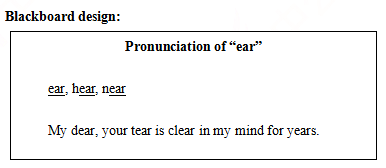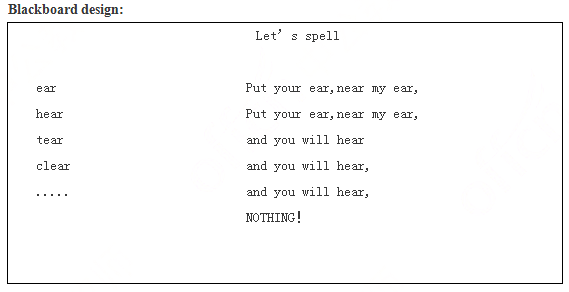问答题Practice 1 How does an earthquake start? What makes an earthquake happen? The rock of the earth’s crust (地壳) may have a “fault”, a kind of break in the surface. The blocks which make up the earth move, and sometimes this may cause the sides of the fa
题目
相似问题和答案
第1题:
What does the text mainly tell us?
A. Tips on an important social skill. B. Importance of attending parties.
C. How to make use of associations. D. How to recite and repeat names.
第2题:
What can be said about the experiments at Rocky Mountain Arsenal?
A) They have no practical value in earthquake prevention.
B) They may have practical value in earthquake prevention.
C) They are certain to have practical value in earthquake prevention.
D) The article does not say anything about their practical value in earthquake prevention.
答案:D
[试题分析] 推断题。
[详细解答] 根据上一题,知道了研究experiments at Rocky Mountain Arsenal的意义,显然可判断:They may have practical value in earthquake prevention,因此,答案为B。
第3题:
如果发现有人休克,保安应怎么处置?
A.How does a security deal with the person if he finds he lost his consciousness?
B.What does a security hold a person if he finds he lost his consciousness?
C.How does a security handle the person if he finds he is injured?
D.What will a security deal with the person if he finds a man involved in a case?
第4题:

二、考题解析
【教案】
Teaching aims
Knowledge aim: students will know the pronunciation of the group of letter “ear”.
Ability aim: students can read words with “ear” when they learn vocabulary.
Emotional aim: students will be more interested in speaking English.
Key and difficult points:
How to pronounce the group of letter “ear”.
Teaching procedure:
Step 1: Warming-up
After greeting students, the teacher plays a game to warm up the class: I say you point. The teacher speaks out a certain part of the body and students point it quickly. For example: point your eye! Point your ear! Point your hand!
Step 2: Presentation
Draw a ear on the blackboard and ask students what it is. Write down the word. Then ask what ears can be used to, and they will say we use ear to hear something. Write down word “hear”. Then do the action of hearing and put hands near the ear, and write down the word “near”.
Ask students to read the three words after the teacher, and find out the similarity among them. After discussion, they will say all these words have “ear”. Then ask students how to pronounce this group of letter. We will know it pronounce as /ir/.
Step 3: practice
Give students some other words with the group of letter “ear” and ask students to read them by groups. For example, a sentence “my dear, your tear is clear in my mind for years”. Then students can have a brainstorming and think of more words with “ear”.
Play a game Hot potato to practice these words. The teacher plays a piece of music. When the music is playing, students pass the ball from one to another. When the music stops, the one who gets the ball should read words on the blackboard.
Step4: Production
Do a chant with students: put your ear, near my ear, and you will hear, and you will hear, and you will hear, NOTHING!

第5题:
On the whole, the passage is about______.
A. how to start a university
B. the world-famous colleges in America
C. how colleges have changed
D. what kind of lesson each college teaches
40.答案为C 全文主要讲述大学的变迁,比较四个选项,C为最佳答案。
第6题:
How does a process description function?
A. It describes what an object is like.
B. It explains how something works.
C. It explains how to perform. a process.
第7题:
What is the most appropriate title for the passage?
A) Dangers of Earthquakes.
B) Earthquake Belts and Prediction.
C) Earthquake Prediction and Control.
D) Earthquake Engineering in California.
答案:C
[试题分析] 文章主旨题。
[详细解答] 文章第一段讲述美国政府正在研究的有关地震的课题,接下来说了正在进行的工作,对问题的解决作了展望,最后,介绍了现阶段取得的成果。根据这些内容,我们可以判断,选择Earthquake Prediction and Control作标题.更有概括性,因此,正确答案为C。
第8题:
Which of the following proverbs is closest to the message the text tries to convey?
[A] “Faith will move mountains.”
[B] “One reaps what one sows.”
[C] “Practice makes perfect.”
[D] “Like father, like son”
第9题:
--Sure.___________.
B.What' s up?
C.Take your time.
D.It makes no difference.
第10题:

二、考题解析
【教案】
Teaching aims:
Knowledge aim: Students can understand the pronunciation of “ear”, and get some simple spelling rules.
Ability aim: Students can read the words with the pronunciation of “ear” correctly by listening and speaking. Ability of listening and speaking will be improved.
Emotional aim: Students can increase their interests in learning English.
Key and difficult point:
Key points: Students can understand the pronunciation of “ear”, and how how to read the words contain “ear”, such as hear, near and etc.
Difficult points: Students can master the pronunciation of “ear” and read the related words correctly.
Teaching procedure:
Step 1: Warming-up
Greeting the students.
Sing a song: Head shoulder keens and toes.
Step 2: Presentation
1. Show the chant and ask the students the question: Can you find the same letter combination in these words?
2. Listen to the tape and let students pay attention to the pronunciation of “ear”, and then ask the students question: what does “ear” sounds like in these words?
3. Teacher the pronunciation of “ear” ,and let students pay attention to the teacher’s mouth.
4. Game: Play the finger show to practice the new words.
Step 3: Practice
Find more words with “ear” such as tear, dear, clear... and ask students to try to read by themselves and then invite some of them to share with the class. The teacher should act the role of monitor.
Step4: Production
1. Ask students to make up their own sentences by using the words learned today, such as “He hears the bad news,and then his tears falls down. ”.
2. Reading competition: let students to read the chant as quickly as possible, and then let students choose the best one.
Step5: Summary and homework
1. Summary: ask students summary what have learned in the class.
2. Homework:
(1) read these word after class.
(2) Find more words with “ear” and make another chant.

